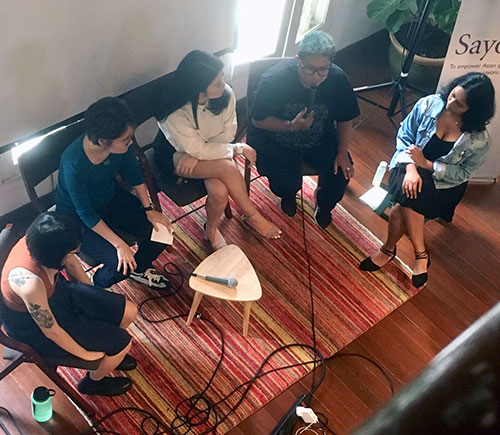
On 28th October, almost 60 women turned up to attend a panel discussion organised by Sayoni titled "Where Are All the LBQ Spaces?". The event was held at The Moon, an almost ethereal café-bookstore initially conceived of by its owner as a space for women, by women.
The panel comprised four speakers: Kim from Two Queens Asia, Norah from She+Pride, Tiffany from The Bi+ Collective and Alina from Sayoni, and the session was moderated by Leanna, a Sayoni volunteer. Here are three highlights from the discussion:
1. There is no one way to define and construct LBQ spaces
When the speakers were asked about why their groups were formed, a common reason was echoed: to create safe spaces for LBQ women. However, their motivations differed.
Sayoni was formed just as online communities appeared. Its online forums allowed LBQ women to communicate in relative anonymity, which then provided a platform for women to safely take their interactions offline.
For Tiffany, The Bi+ Collective was initially a way for her to make friends. She built a community where she could meet individuals who were like her, without having to feel like she was not gay or straight enough. Two Queens was formed simply for women to have fun through parties, and not necessarily discuss cerebral or existential issues.
It was not just the reasons behind the creation of these spaces which differed. During the Q&A session, an audience member suggested that LBQ spaces do not necessarily have to be rigid in form. She introduced the concept of collaborating with adjacent spaces, somewhere that is physically near to an LBQ space but not exactly like it. It may be more sustainable to go beyond creating exclusive LBQ spaces and look into how conventional spaces can accommodate LBQ women, she said.
2. The only way that LBQ spaces can be kept alive is for people to occupy those spaces
A considerable segment of the event revolved around understanding why LBQ spaces are so limited, and why they were disappearing. Norah said that people in the United States were open with their sexuality, and may not need a physical safe space. She also suggested considering the possibility that women do not spend as much as men. Indeed, spaces devoted exclusively to LBQ women have to maintain a balance between restricting their patronage and being economically viable.
Kim added that although Two Queens is a commercial entity, it does not make a lot of money. As the "scene" changes and LBQ women express different tastes and preferences, the financial viability of LBQ spaces is also affected. Tiffany expressed similar concerns, saying that The Bi+ Collective relies on limited contributions. One solution presented by Alina is to ensure that temporary spaces like the Internet thrive, despite limited permanent physical spaces.
Whatever its form, a space can only serve its purpose if an occupant engages and negotiates with it. For this to happen, we need to show up. Kim talked about her experience having organised an all-girls’ party at a club, which was eventually attended by only 50 ladies. It was not the most encouraging experience. In this case, two is not company, and three sure isn’t a crowd (neither is 50!).
An LBQ space does not exist in and of itself. LBQ women’s experiences also help to define the space. Participating in dialogues and indicating our interest on Facebook is important, but what is critical to the survival of LBQ spaces is for us to actually be present.

3. Visibility is not just about being out, loud and proud
Norah emphasised the importance of visibility. For example, She+Pride’s events are held in public spaces. She said, “People cannot see us as scared… we cannot be hiding.”
Indeed, some of us are more comfortable with our sexuality. But others may not be. LBQ spaces are important not just as political acts of protest but also as spaces for affirmation and healing. As one audience member mentioned, LBQ women do not have to say anything in these spaces, they can just “soak in the atmosphere”.
Norah’s notion of visibility still applies. Visibility isn’t just about coming out and staying out. Visibility is also about easing into yourself as an LBQ woman. It is primarily about seeing yourself, and not necessarily being seen by others. LBQ spaces would fail to serve their function if we are not visible to ourselves.
However, visibility is important not just for the community but also those outside of it. Though a painful process, visibility helps to develop acceptance in society. Visibility is also important because without it, there is no way to catch the attention of those who need LBQ spaces most. Kim spoke about how Two Queens has had to tread carefully when it comes to marketing its all-girls events. From her experience, there are people bent on ensuring that public spaces are free of the “gay agenda”.
At the core of it, a space is only what we make it out to be. As Norah said during the discussion, it is not fair for the community to rely on the same people to maintain LBQ spaces. Hence, it is important for us to strengthen the existing spaces that we have. It is not just a question of how many LBQ spaces we have, but more importantly, the degree of our interactions with these spaces.
